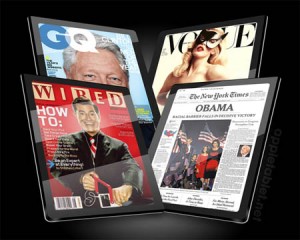By
Emily WilsonMay 8, 2019
Amazon is currently pitching U.S.-based publishers like The New York Times and BuzzFeed on deals that would reward them for expanding internationally. As it currently works, Amazon pays Internet publishers that use affiliate links on their sites. When consumers click, visit Amazon, and make a purchase, the publishers get paid. Amazon seeks to expand its own international presence via the publishers getting more readers outside of the U.S., and it’s willing to cut deals to give publishers money up front rather than waiting until purchases.
Continue reading Amazon to Pay U.S. Publishers For International Expansion
By
emeadowsApril 18, 2013
As the shift to mobile devices continues, media including e-books, music and video are becoming increasingly popular when distributed through a “less is more” model. Consumers are gravitating to short form content they find more convenient. Amazon has brought back serial novels for its Kindle, Capitol Records Nashville has debuted at number one with its EP releases, and shorter films such as the 42-minute documentary “Inocente” are drawing viewers and winning awards. Continue reading Less is More as Consumers Turn to Short Form Content
By
emeadowsMarch 26, 2013
The Supreme Court issued a pair of decisions last week that could have a significant impact on digital publishing and copyrighted products. The first ruling makes it potentially easier to import and sell textbooks from abroad, following a lawsuit involving a college student who was importing cheaper textbooks and selling them for a profit. The second decision makes it more difficult for plaintiffs in class-action suits to stay out of federal court. Continue reading Supreme Court Rules it is Legal to Sell Imported Textbooks

By
Rob ScottApril 5, 2011
San Jose Mercury News offers an interesting look at the pros and cons regarding Apple’s recent push into digital publishing. The company’s new subscription model could potentially make it the “online gatekeeper” as the digital newsstand for newspaper and magazine content (similar to its current dominance in digital music), but the model has met with some resistance from the industry and mixed reviews from analysts.
 On the upside, Apple’s model offers publishers instant exposure to the many Apps Store subscribers and makes subscribing a simple, proven process. Recognizing this, some publishers are already on board. The iPad-only digital newspaper The Daily from News Corp., for example, launched around the same time Apple announced its digital publishing plan — while some newspapers, including the Mercury News and the New York Times, are currently test-running the subscription model.
On the upside, Apple’s model offers publishers instant exposure to the many Apps Store subscribers and makes subscribing a simple, proven process. Recognizing this, some publishers are already on board. The iPad-only digital newspaper The Daily from News Corp., for example, launched around the same time Apple announced its digital publishing plan — while some newspapers, including the Mercury News and the New York Times, are currently test-running the subscription model.
The proposal is a bold move by Apple, which takes a 30 percent cut for each newspaper or magazine subscriber via iTunes. And what may draw the most controversy, the model also restricts publishers from offering lower prices than what they charge through iPhone and iPad apps.
The article raises some possible negative implications, including:
1. There are concerns from European antitrust authorities, which could eventually place a target on Apple.
2. By “playing hardball” with publishers, Apple may run the risk of driving its customers to other tablet-makers.
3. Publishers may fear that Apple is putting itself between them and their new customers.

